Critical Analysis of Policy, Governance and Democracy 7PIRS021W
VerifiedAdded on 2023/06/03
|12
|3379
|468
Essay
AI Summary
This essay provides a comprehensive analysis of policy, governance, and democracy from an international perspective, drawing upon various approaches of new institutionalism, including normative institutionalism, rational choice institutionalism, and historical institutionalism, alongside actor-centered institutionalism, to understand policy change. It critically evaluates the strengths and weaknesses of each approach, emphasizing the role of institutions in shaping public policies and the interactions among actors within these frameworks. The essay also considers the limitations of sociological institutionalism in explaining policy change and highlights the importance of actor-centered historical institutionalism in understanding how policy change occurs through the actions of involved actors, rather than solely through external shocks. It concludes with a valuation of Scharpf and Mayntz's proposition, offering a nuanced perspective on the dynamics of policy, governance, and democracy in international contexts.
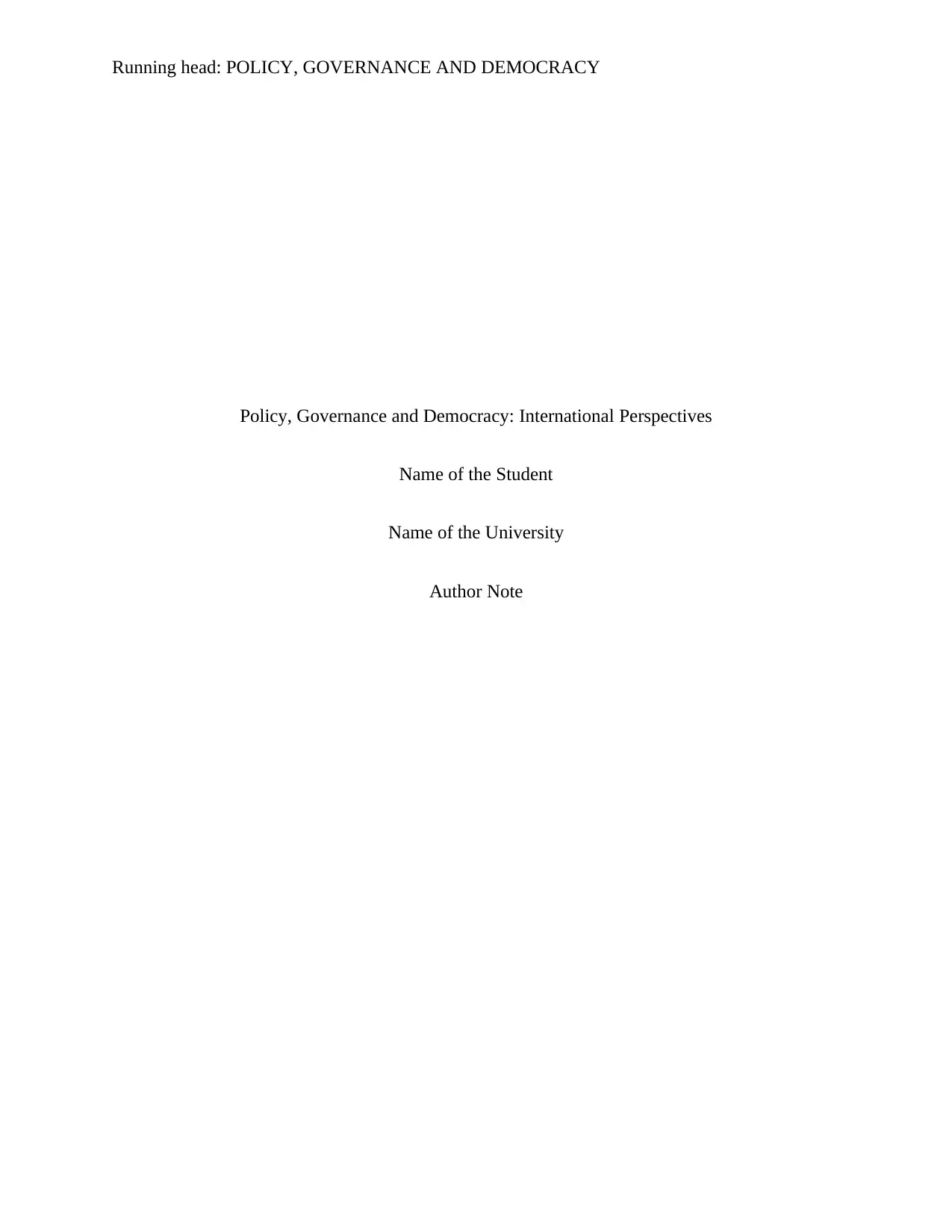
Running head: POLICY, GOVERNANCE AND DEMOCRACY
Policy, Governance and Democracy: International Perspectives
Name of the Student
Name of the University
Author Note
Policy, Governance and Democracy: International Perspectives
Name of the Student
Name of the University
Author Note
Paraphrase This Document
Need a fresh take? Get an instant paraphrase of this document with our AI Paraphraser
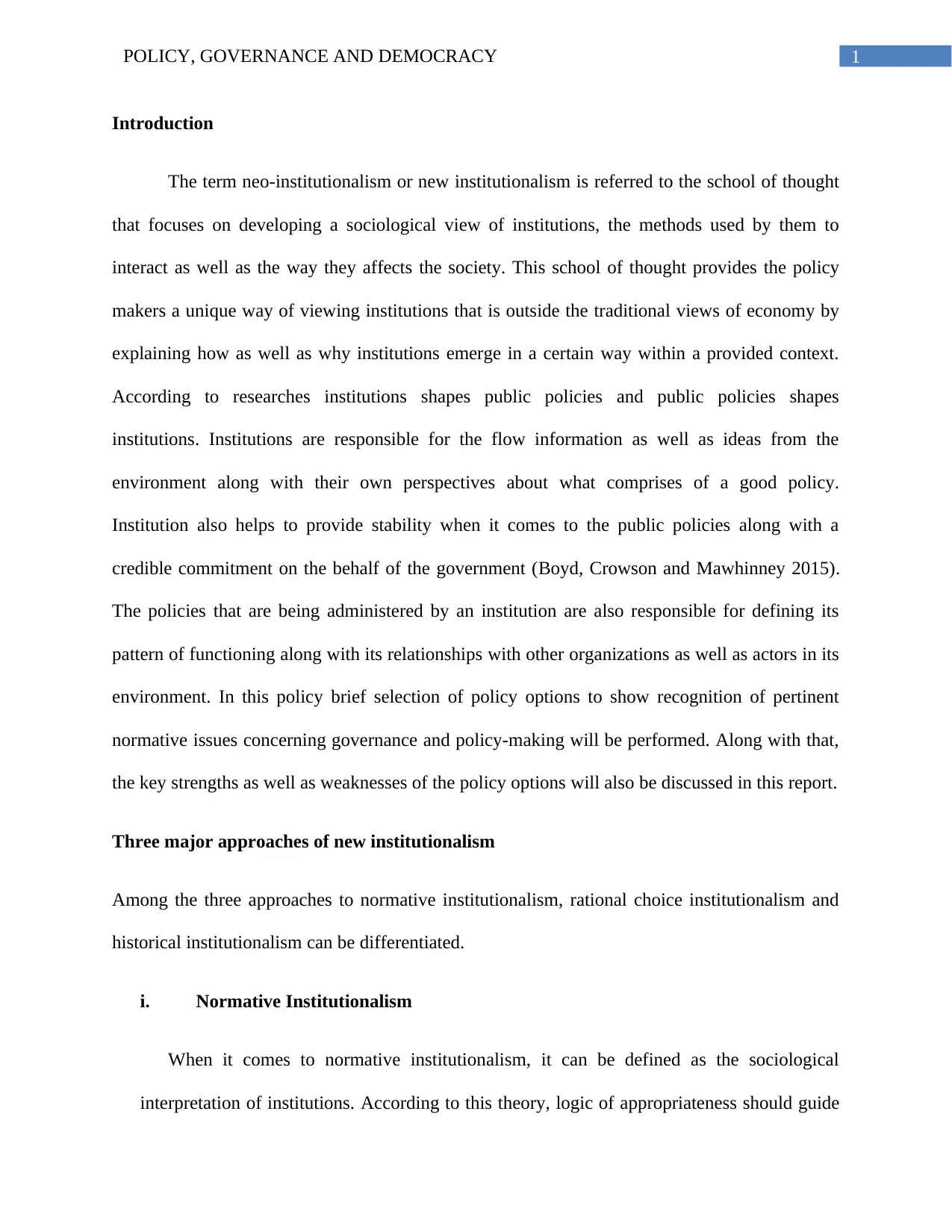
1POLICY, GOVERNANCE AND DEMOCRACY
Introduction
The term neo-institutionalism or new institutionalism is referred to the school of thought
that focuses on developing a sociological view of institutions, the methods used by them to
interact as well as the way they affects the society. This school of thought provides the policy
makers a unique way of viewing institutions that is outside the traditional views of economy by
explaining how as well as why institutions emerge in a certain way within a provided context.
According to researches institutions shapes public policies and public policies shapes
institutions. Institutions are responsible for the flow information as well as ideas from the
environment along with their own perspectives about what comprises of a good policy.
Institution also helps to provide stability when it comes to the public policies along with a
credible commitment on the behalf of the government (Boyd, Crowson and Mawhinney 2015).
The policies that are being administered by an institution are also responsible for defining its
pattern of functioning along with its relationships with other organizations as well as actors in its
environment. In this policy brief selection of policy options to show recognition of pertinent
normative issues concerning governance and policy-making will be performed. Along with that,
the key strengths as well as weaknesses of the policy options will also be discussed in this report.
Three major approaches of new institutionalism
Among the three approaches to normative institutionalism, rational choice institutionalism and
historical institutionalism can be differentiated.
i. Normative Institutionalism
When it comes to normative institutionalism, it can be defined as the sociological
interpretation of institutions. According to this theory, logic of appropriateness should guide
Introduction
The term neo-institutionalism or new institutionalism is referred to the school of thought
that focuses on developing a sociological view of institutions, the methods used by them to
interact as well as the way they affects the society. This school of thought provides the policy
makers a unique way of viewing institutions that is outside the traditional views of economy by
explaining how as well as why institutions emerge in a certain way within a provided context.
According to researches institutions shapes public policies and public policies shapes
institutions. Institutions are responsible for the flow information as well as ideas from the
environment along with their own perspectives about what comprises of a good policy.
Institution also helps to provide stability when it comes to the public policies along with a
credible commitment on the behalf of the government (Boyd, Crowson and Mawhinney 2015).
The policies that are being administered by an institution are also responsible for defining its
pattern of functioning along with its relationships with other organizations as well as actors in its
environment. In this policy brief selection of policy options to show recognition of pertinent
normative issues concerning governance and policy-making will be performed. Along with that,
the key strengths as well as weaknesses of the policy options will also be discussed in this report.
Three major approaches of new institutionalism
Among the three approaches to normative institutionalism, rational choice institutionalism and
historical institutionalism can be differentiated.
i. Normative Institutionalism
When it comes to normative institutionalism, it can be defined as the sociological
interpretation of institutions. According to this theory, logic of appropriateness should guide
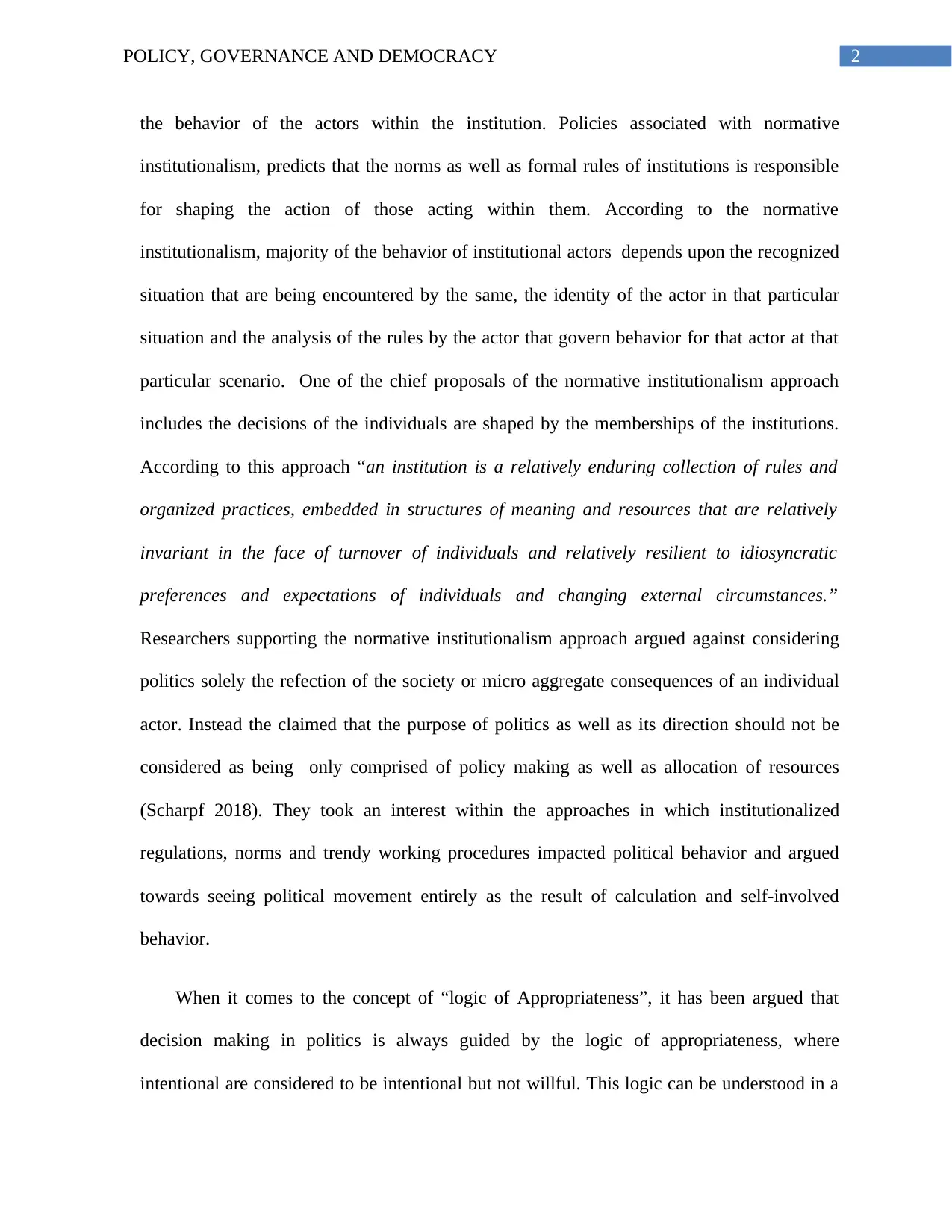
2POLICY, GOVERNANCE AND DEMOCRACY
the behavior of the actors within the institution. Policies associated with normative
institutionalism, predicts that the norms as well as formal rules of institutions is responsible
for shaping the action of those acting within them. According to the normative
institutionalism, majority of the behavior of institutional actors depends upon the recognized
situation that are being encountered by the same, the identity of the actor in that particular
situation and the analysis of the rules by the actor that govern behavior for that actor at that
particular scenario. One of the chief proposals of the normative institutionalism approach
includes the decisions of the individuals are shaped by the memberships of the institutions.
According to this approach “an institution is a relatively enduring collection of rules and
organized practices, embedded in structures of meaning and resources that are relatively
invariant in the face of turnover of individuals and relatively resilient to idiosyncratic
preferences and expectations of individuals and changing external circumstances.”
Researchers supporting the normative institutionalism approach argued against considering
politics solely the refection of the society or micro aggregate consequences of an individual
actor. Instead the claimed that the purpose of politics as well as its direction should not be
considered as being only comprised of policy making as well as allocation of resources
(Scharpf 2018). They took an interest within the approaches in which institutionalized
regulations, norms and trendy working procedures impacted political behavior and argued
towards seeing political movement entirely as the result of calculation and self-involved
behavior.
When it comes to the concept of “logic of Appropriateness”, it has been argued that
decision making in politics is always guided by the logic of appropriateness, where
intentional are considered to be intentional but not willful. This logic can be understood in a
the behavior of the actors within the institution. Policies associated with normative
institutionalism, predicts that the norms as well as formal rules of institutions is responsible
for shaping the action of those acting within them. According to the normative
institutionalism, majority of the behavior of institutional actors depends upon the recognized
situation that are being encountered by the same, the identity of the actor in that particular
situation and the analysis of the rules by the actor that govern behavior for that actor at that
particular scenario. One of the chief proposals of the normative institutionalism approach
includes the decisions of the individuals are shaped by the memberships of the institutions.
According to this approach “an institution is a relatively enduring collection of rules and
organized practices, embedded in structures of meaning and resources that are relatively
invariant in the face of turnover of individuals and relatively resilient to idiosyncratic
preferences and expectations of individuals and changing external circumstances.”
Researchers supporting the normative institutionalism approach argued against considering
politics solely the refection of the society or micro aggregate consequences of an individual
actor. Instead the claimed that the purpose of politics as well as its direction should not be
considered as being only comprised of policy making as well as allocation of resources
(Scharpf 2018). They took an interest within the approaches in which institutionalized
regulations, norms and trendy working procedures impacted political behavior and argued
towards seeing political movement entirely as the result of calculation and self-involved
behavior.
When it comes to the concept of “logic of Appropriateness”, it has been argued that
decision making in politics is always guided by the logic of appropriateness, where
intentional are considered to be intentional but not willful. This logic can be understood in a
⊘ This is a preview!⊘
Do you want full access?
Subscribe today to unlock all pages.

Trusted by 1+ million students worldwide
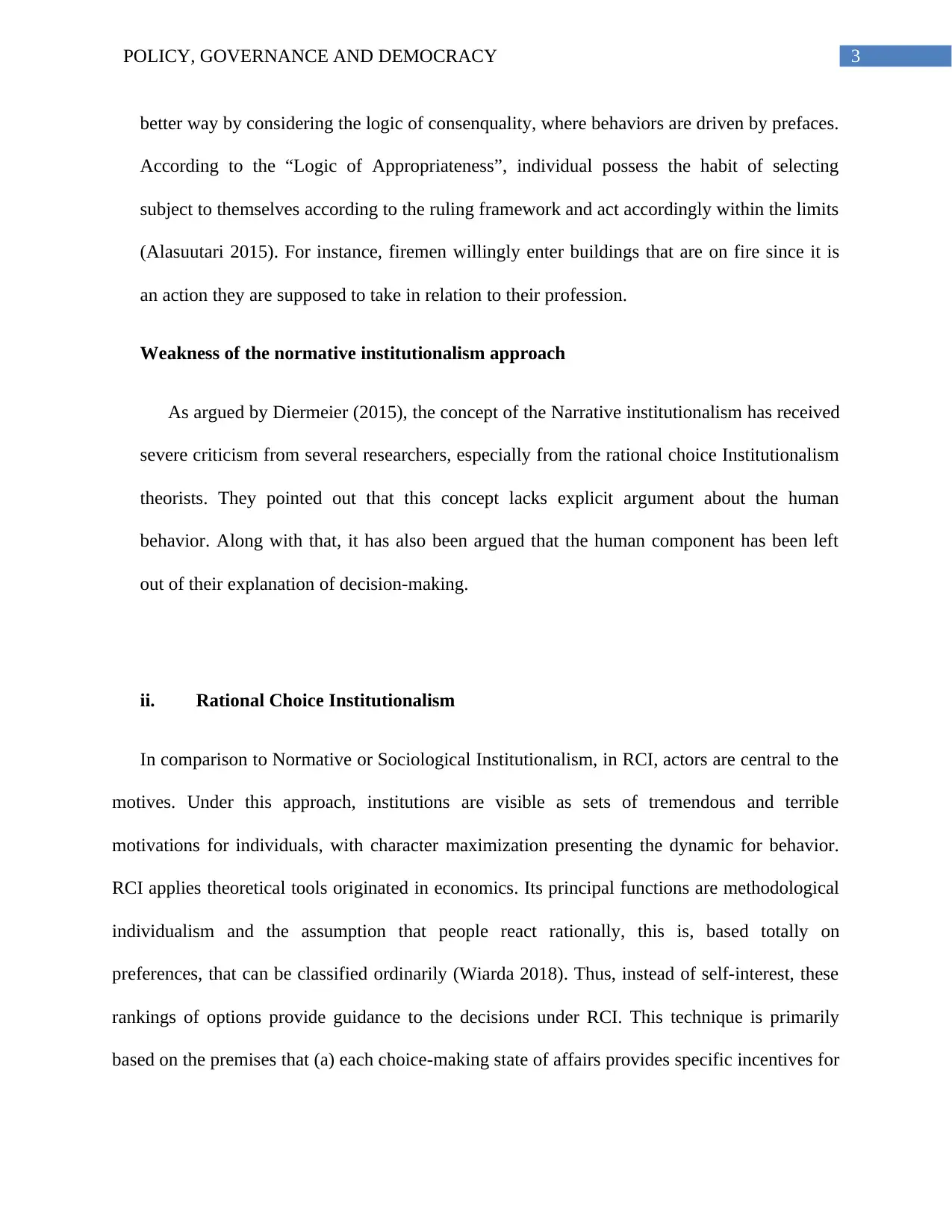
3POLICY, GOVERNANCE AND DEMOCRACY
better way by considering the logic of consenquality, where behaviors are driven by prefaces.
According to the “Logic of Appropriateness”, individual possess the habit of selecting
subject to themselves according to the ruling framework and act accordingly within the limits
(Alasuutari 2015). For instance, firemen willingly enter buildings that are on fire since it is
an action they are supposed to take in relation to their profession.
Weakness of the normative institutionalism approach
As argued by Diermeier (2015), the concept of the Narrative institutionalism has received
severe criticism from several researchers, especially from the rational choice Institutionalism
theorists. They pointed out that this concept lacks explicit argument about the human
behavior. Along with that, it has also been argued that the human component has been left
out of their explanation of decision-making.
ii. Rational Choice Institutionalism
In comparison to Normative or Sociological Institutionalism, in RCI, actors are central to the
motives. Under this approach, institutions are visible as sets of tremendous and terrible
motivations for individuals, with character maximization presenting the dynamic for behavior.
RCI applies theoretical tools originated in economics. Its principal functions are methodological
individualism and the assumption that people react rationally, this is, based totally on
preferences, that can be classified ordinarily (Wiarda 2018). Thus, instead of self-interest, these
rankings of options provide guidance to the decisions under RCI. This technique is primarily
based on the premises that (a) each choice-making state of affairs provides specific incentives for
better way by considering the logic of consenquality, where behaviors are driven by prefaces.
According to the “Logic of Appropriateness”, individual possess the habit of selecting
subject to themselves according to the ruling framework and act accordingly within the limits
(Alasuutari 2015). For instance, firemen willingly enter buildings that are on fire since it is
an action they are supposed to take in relation to their profession.
Weakness of the normative institutionalism approach
As argued by Diermeier (2015), the concept of the Narrative institutionalism has received
severe criticism from several researchers, especially from the rational choice Institutionalism
theorists. They pointed out that this concept lacks explicit argument about the human
behavior. Along with that, it has also been argued that the human component has been left
out of their explanation of decision-making.
ii. Rational Choice Institutionalism
In comparison to Normative or Sociological Institutionalism, in RCI, actors are central to the
motives. Under this approach, institutions are visible as sets of tremendous and terrible
motivations for individuals, with character maximization presenting the dynamic for behavior.
RCI applies theoretical tools originated in economics. Its principal functions are methodological
individualism and the assumption that people react rationally, this is, based totally on
preferences, that can be classified ordinarily (Wiarda 2018). Thus, instead of self-interest, these
rankings of options provide guidance to the decisions under RCI. This technique is primarily
based on the premises that (a) each choice-making state of affairs provides specific incentives for
Paraphrase This Document
Need a fresh take? Get an instant paraphrase of this document with our AI Paraphraser
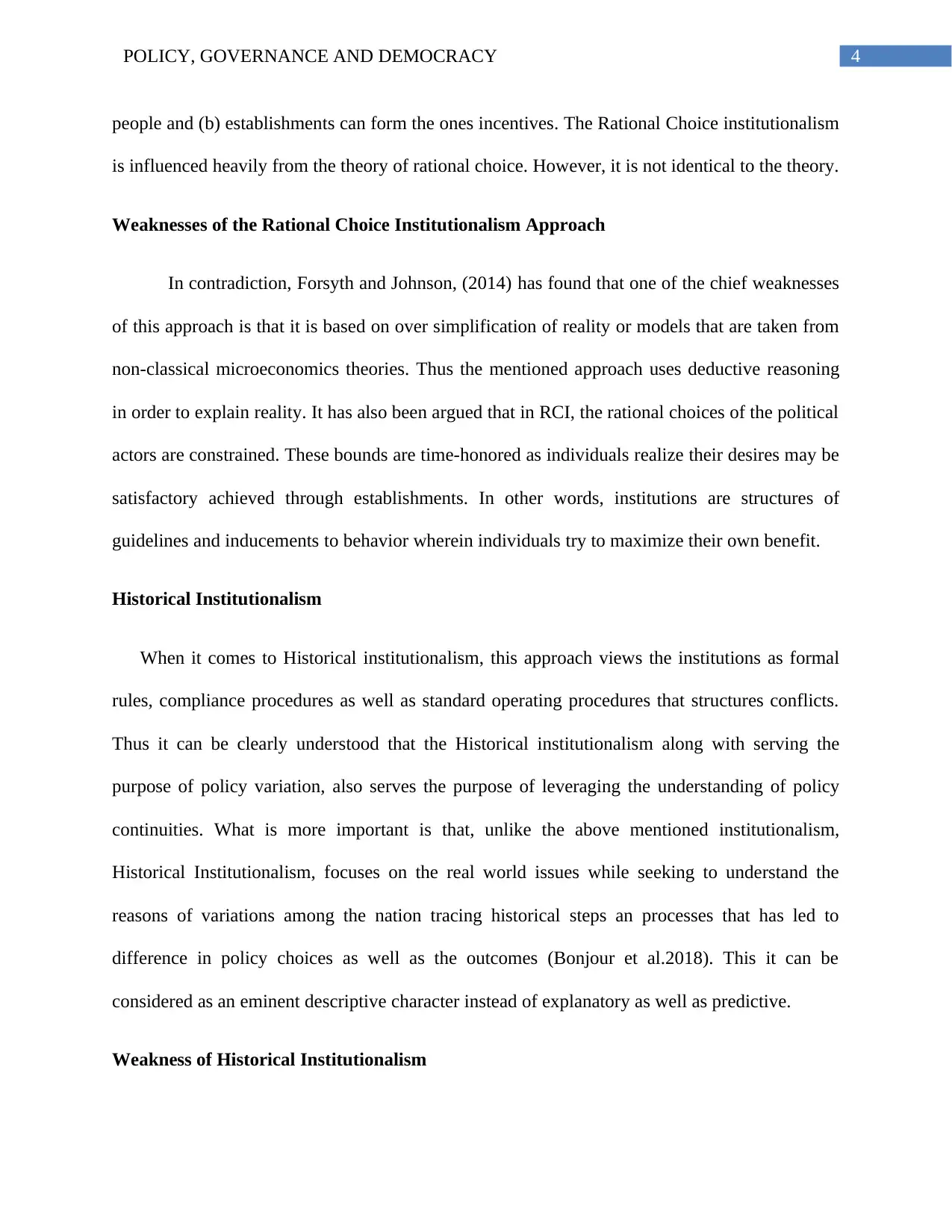
4POLICY, GOVERNANCE AND DEMOCRACY
people and (b) establishments can form the ones incentives. The Rational Choice institutionalism
is influenced heavily from the theory of rational choice. However, it is not identical to the theory.
Weaknesses of the Rational Choice Institutionalism Approach
In contradiction, Forsyth and Johnson, (2014) has found that one of the chief weaknesses
of this approach is that it is based on over simplification of reality or models that are taken from
non-classical microeconomics theories. Thus the mentioned approach uses deductive reasoning
in order to explain reality. It has also been argued that in RCI, the rational choices of the political
actors are constrained. These bounds are time-honored as individuals realize their desires may be
satisfactory achieved through establishments. In other words, institutions are structures of
guidelines and inducements to behavior wherein individuals try to maximize their own benefit.
Historical Institutionalism
When it comes to Historical institutionalism, this approach views the institutions as formal
rules, compliance procedures as well as standard operating procedures that structures conflicts.
Thus it can be clearly understood that the Historical institutionalism along with serving the
purpose of policy variation, also serves the purpose of leveraging the understanding of policy
continuities. What is more important is that, unlike the above mentioned institutionalism,
Historical Institutionalism, focuses on the real world issues while seeking to understand the
reasons of variations among the nation tracing historical steps an processes that has led to
difference in policy choices as well as the outcomes (Bonjour et al.2018). This it can be
considered as an eminent descriptive character instead of explanatory as well as predictive.
Weakness of Historical Institutionalism
people and (b) establishments can form the ones incentives. The Rational Choice institutionalism
is influenced heavily from the theory of rational choice. However, it is not identical to the theory.
Weaknesses of the Rational Choice Institutionalism Approach
In contradiction, Forsyth and Johnson, (2014) has found that one of the chief weaknesses
of this approach is that it is based on over simplification of reality or models that are taken from
non-classical microeconomics theories. Thus the mentioned approach uses deductive reasoning
in order to explain reality. It has also been argued that in RCI, the rational choices of the political
actors are constrained. These bounds are time-honored as individuals realize their desires may be
satisfactory achieved through establishments. In other words, institutions are structures of
guidelines and inducements to behavior wherein individuals try to maximize their own benefit.
Historical Institutionalism
When it comes to Historical institutionalism, this approach views the institutions as formal
rules, compliance procedures as well as standard operating procedures that structures conflicts.
Thus it can be clearly understood that the Historical institutionalism along with serving the
purpose of policy variation, also serves the purpose of leveraging the understanding of policy
continuities. What is more important is that, unlike the above mentioned institutionalism,
Historical Institutionalism, focuses on the real world issues while seeking to understand the
reasons of variations among the nation tracing historical steps an processes that has led to
difference in policy choices as well as the outcomes (Bonjour et al.2018). This it can be
considered as an eminent descriptive character instead of explanatory as well as predictive.
Weakness of Historical Institutionalism
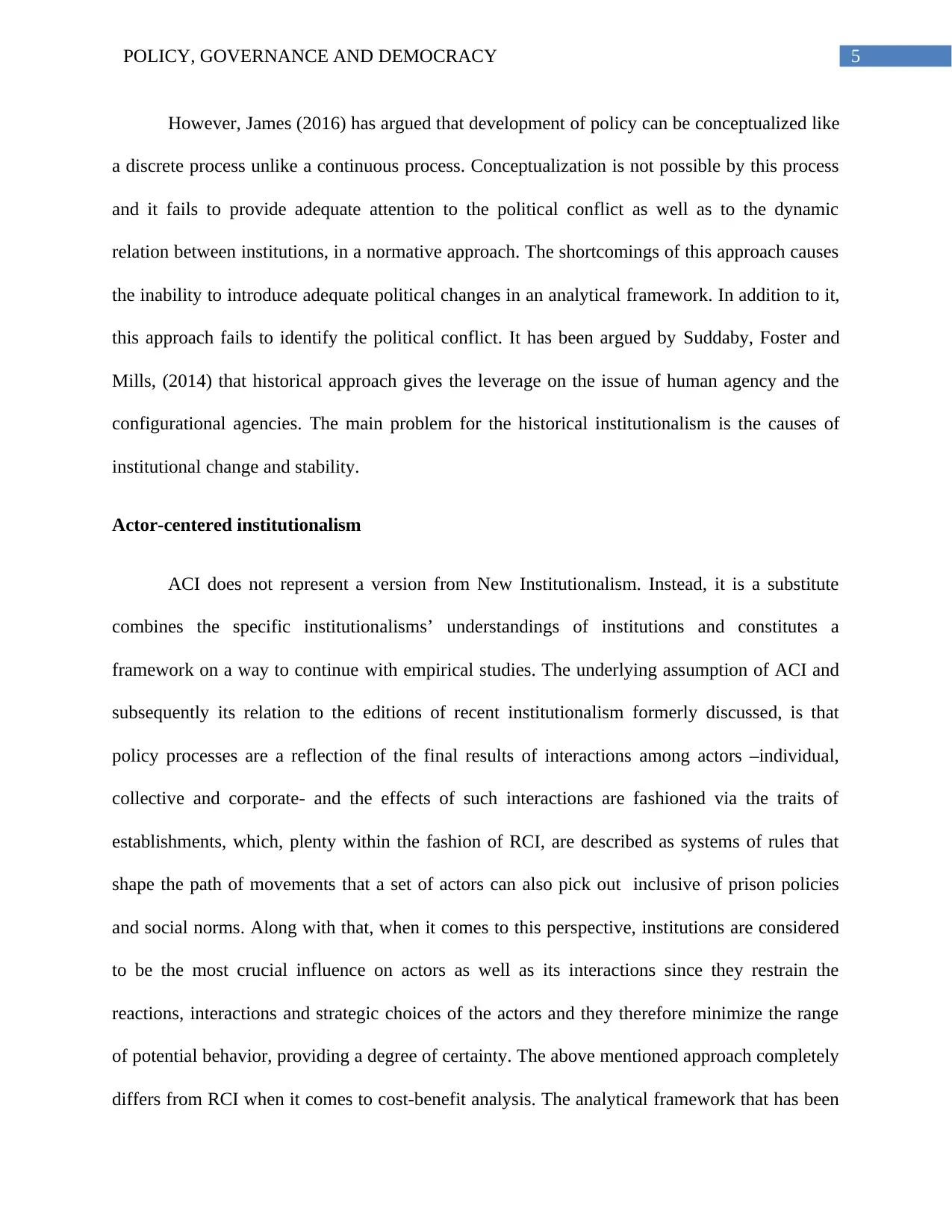
5POLICY, GOVERNANCE AND DEMOCRACY
However, James (2016) has argued that development of policy can be conceptualized like
a discrete process unlike a continuous process. Conceptualization is not possible by this process
and it fails to provide adequate attention to the political conflict as well as to the dynamic
relation between institutions, in a normative approach. The shortcomings of this approach causes
the inability to introduce adequate political changes in an analytical framework. In addition to it,
this approach fails to identify the political conflict. It has been argued by Suddaby, Foster and
Mills, (2014) that historical approach gives the leverage on the issue of human agency and the
configurational agencies. The main problem for the historical institutionalism is the causes of
institutional change and stability.
Actor-centered institutionalism
ACI does not represent a version from New Institutionalism. Instead, it is a substitute
combines the specific institutionalisms’ understandings of institutions and constitutes a
framework on a way to continue with empirical studies. The underlying assumption of ACI and
subsequently its relation to the editions of recent institutionalism formerly discussed, is that
policy processes are a reflection of the final results of interactions among actors –individual,
collective and corporate- and the effects of such interactions are fashioned via the traits of
establishments, which, plenty within the fashion of RCI, are described as systems of rules that
shape the path of movements that a set of actors can also pick out inclusive of prison policies
and social norms. Along with that, when it comes to this perspective, institutions are considered
to be the most crucial influence on actors as well as its interactions since they restrain the
reactions, interactions and strategic choices of the actors and they therefore minimize the range
of potential behavior, providing a degree of certainty. The above mentioned approach completely
differs from RCI when it comes to cost-benefit analysis. The analytical framework that has been
However, James (2016) has argued that development of policy can be conceptualized like
a discrete process unlike a continuous process. Conceptualization is not possible by this process
and it fails to provide adequate attention to the political conflict as well as to the dynamic
relation between institutions, in a normative approach. The shortcomings of this approach causes
the inability to introduce adequate political changes in an analytical framework. In addition to it,
this approach fails to identify the political conflict. It has been argued by Suddaby, Foster and
Mills, (2014) that historical approach gives the leverage on the issue of human agency and the
configurational agencies. The main problem for the historical institutionalism is the causes of
institutional change and stability.
Actor-centered institutionalism
ACI does not represent a version from New Institutionalism. Instead, it is a substitute
combines the specific institutionalisms’ understandings of institutions and constitutes a
framework on a way to continue with empirical studies. The underlying assumption of ACI and
subsequently its relation to the editions of recent institutionalism formerly discussed, is that
policy processes are a reflection of the final results of interactions among actors –individual,
collective and corporate- and the effects of such interactions are fashioned via the traits of
establishments, which, plenty within the fashion of RCI, are described as systems of rules that
shape the path of movements that a set of actors can also pick out inclusive of prison policies
and social norms. Along with that, when it comes to this perspective, institutions are considered
to be the most crucial influence on actors as well as its interactions since they restrain the
reactions, interactions and strategic choices of the actors and they therefore minimize the range
of potential behavior, providing a degree of certainty. The above mentioned approach completely
differs from RCI when it comes to cost-benefit analysis. The analytical framework that has been
⊘ This is a preview!⊘
Do you want full access?
Subscribe today to unlock all pages.

Trusted by 1+ million students worldwide
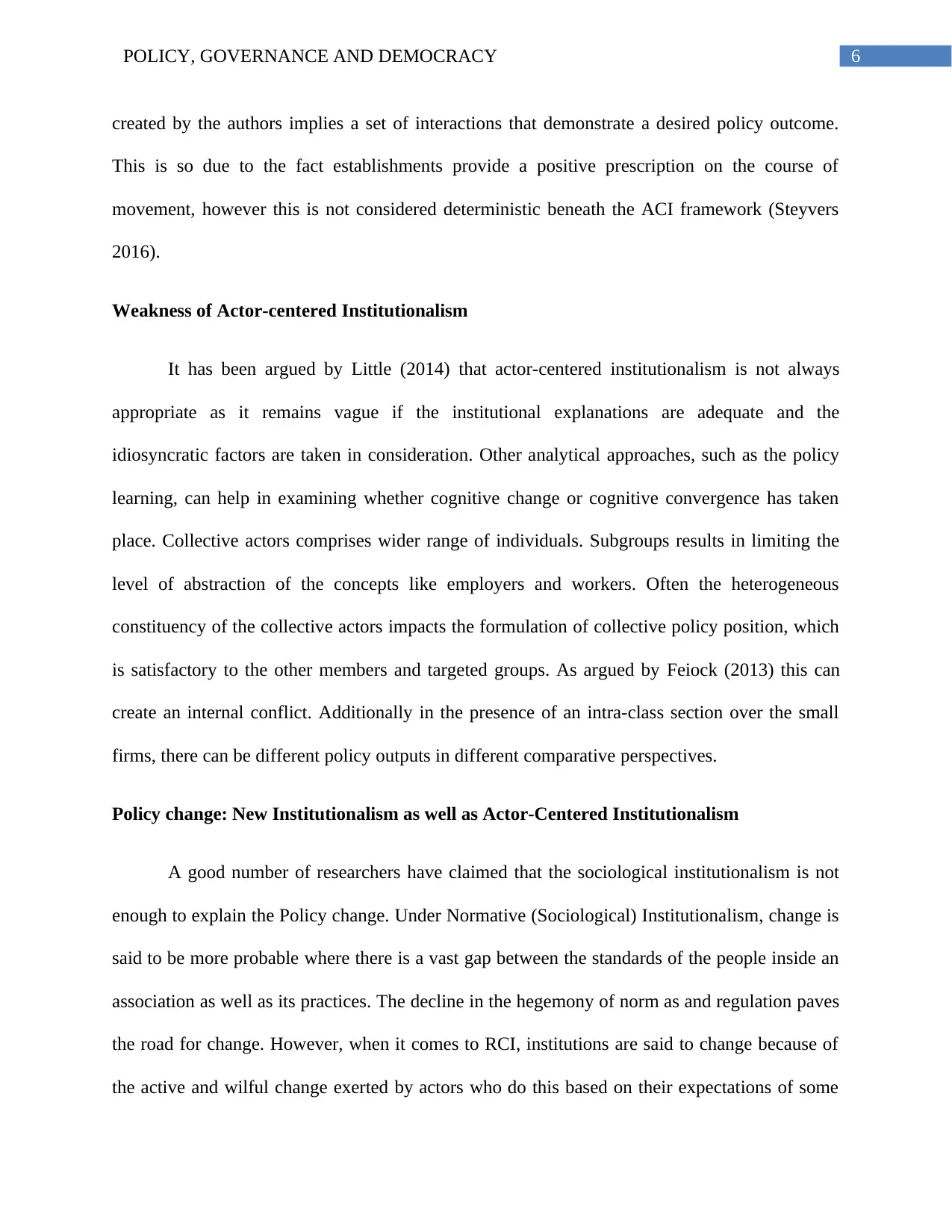
6POLICY, GOVERNANCE AND DEMOCRACY
created by the authors implies a set of interactions that demonstrate a desired policy outcome.
This is so due to the fact establishments provide a positive prescription on the course of
movement, however this is not considered deterministic beneath the ACI framework (Steyvers
2016).
Weakness of Actor-centered Institutionalism
It has been argued by Little (2014) that actor-centered institutionalism is not always
appropriate as it remains vague if the institutional explanations are adequate and the
idiosyncratic factors are taken in consideration. Other analytical approaches, such as the policy
learning, can help in examining whether cognitive change or cognitive convergence has taken
place. Collective actors comprises wider range of individuals. Subgroups results in limiting the
level of abstraction of the concepts like employers and workers. Often the heterogeneous
constituency of the collective actors impacts the formulation of collective policy position, which
is satisfactory to the other members and targeted groups. As argued by Feiock (2013) this can
create an internal conflict. Additionally in the presence of an intra-class section over the small
firms, there can be different policy outputs in different comparative perspectives.
Policy change: New Institutionalism as well as Actor-Centered Institutionalism
A good number of researchers have claimed that the sociological institutionalism is not
enough to explain the Policy change. Under Normative (Sociological) Institutionalism, change is
said to be more probable where there is a vast gap between the standards of the people inside an
association as well as its practices. The decline in the hegemony of norm as and regulation paves
the road for change. However, when it comes to RCI, institutions are said to change because of
the active and wilful change exerted by actors who do this based on their expectations of some
created by the authors implies a set of interactions that demonstrate a desired policy outcome.
This is so due to the fact establishments provide a positive prescription on the course of
movement, however this is not considered deterministic beneath the ACI framework (Steyvers
2016).
Weakness of Actor-centered Institutionalism
It has been argued by Little (2014) that actor-centered institutionalism is not always
appropriate as it remains vague if the institutional explanations are adequate and the
idiosyncratic factors are taken in consideration. Other analytical approaches, such as the policy
learning, can help in examining whether cognitive change or cognitive convergence has taken
place. Collective actors comprises wider range of individuals. Subgroups results in limiting the
level of abstraction of the concepts like employers and workers. Often the heterogeneous
constituency of the collective actors impacts the formulation of collective policy position, which
is satisfactory to the other members and targeted groups. As argued by Feiock (2013) this can
create an internal conflict. Additionally in the presence of an intra-class section over the small
firms, there can be different policy outputs in different comparative perspectives.
Policy change: New Institutionalism as well as Actor-Centered Institutionalism
A good number of researchers have claimed that the sociological institutionalism is not
enough to explain the Policy change. Under Normative (Sociological) Institutionalism, change is
said to be more probable where there is a vast gap between the standards of the people inside an
association as well as its practices. The decline in the hegemony of norm as and regulation paves
the road for change. However, when it comes to RCI, institutions are said to change because of
the active and wilful change exerted by actors who do this based on their expectations of some
Paraphrase This Document
Need a fresh take? Get an instant paraphrase of this document with our AI Paraphraser
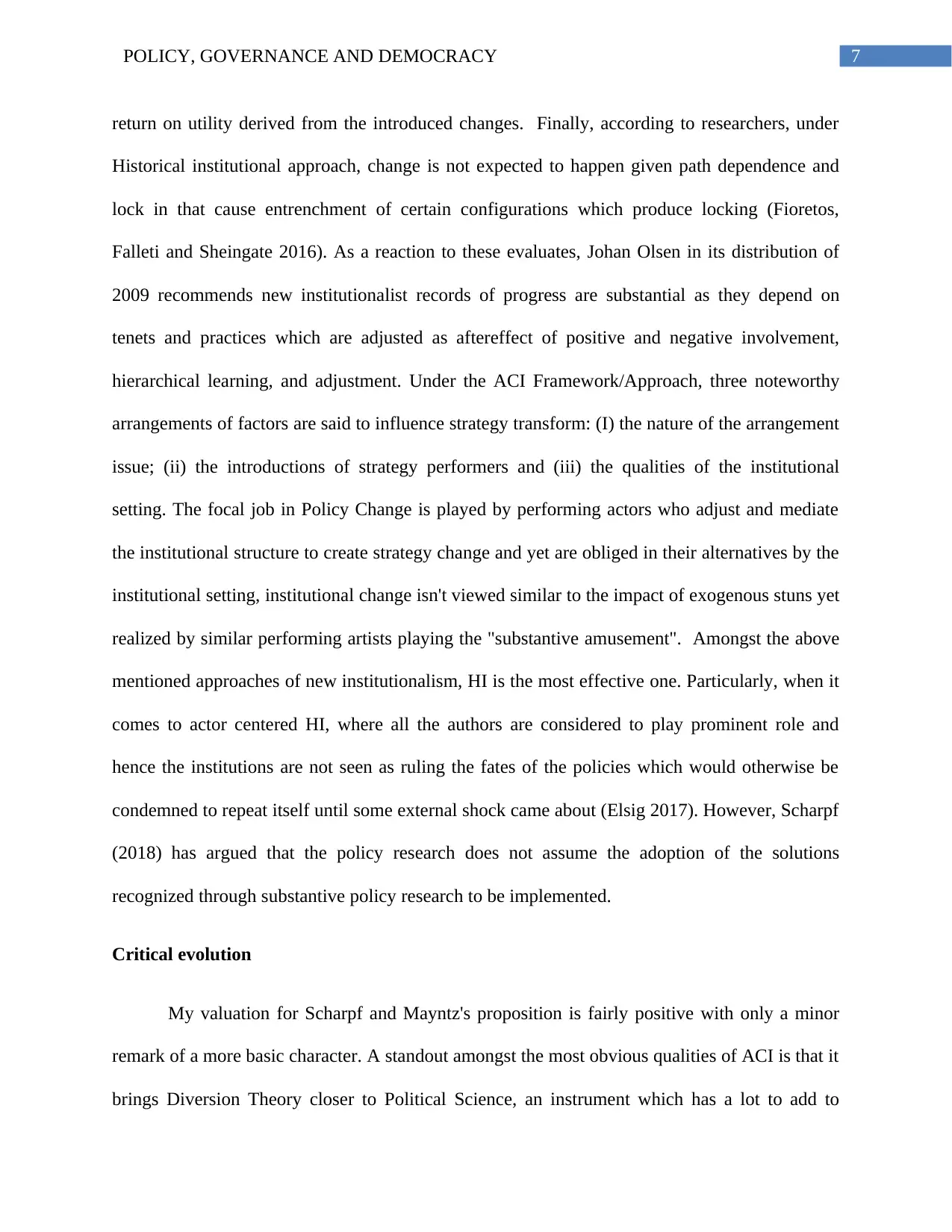
7POLICY, GOVERNANCE AND DEMOCRACY
return on utility derived from the introduced changes. Finally, according to researchers, under
Historical institutional approach, change is not expected to happen given path dependence and
lock in that cause entrenchment of certain configurations which produce locking (Fioretos,
Falleti and Sheingate 2016). As a reaction to these evaluates, Johan Olsen in its distribution of
2009 recommends new institutionalist records of progress are substantial as they depend on
tenets and practices which are adjusted as aftereffect of positive and negative involvement,
hierarchical learning, and adjustment. Under the ACI Framework/Approach, three noteworthy
arrangements of factors are said to influence strategy transform: (I) the nature of the arrangement
issue; (ii) the introductions of strategy performers and (iii) the qualities of the institutional
setting. The focal job in Policy Change is played by performing actors who adjust and mediate
the institutional structure to create strategy change and yet are obliged in their alternatives by the
institutional setting, institutional change isn't viewed similar to the impact of exogenous stuns yet
realized by similar performing artists playing the "substantive amusement". Amongst the above
mentioned approaches of new institutionalism, HI is the most effective one. Particularly, when it
comes to actor centered HI, where all the authors are considered to play prominent role and
hence the institutions are not seen as ruling the fates of the policies which would otherwise be
condemned to repeat itself until some external shock came about (Elsig 2017). However, Scharpf
(2018) has argued that the policy research does not assume the adoption of the solutions
recognized through substantive policy research to be implemented.
Critical evolution
My valuation for Scharpf and Mayntz's proposition is fairly positive with only a minor
remark of a more basic character. A standout amongst the most obvious qualities of ACI is that it
brings Diversion Theory closer to Political Science, an instrument which has a lot to add to
return on utility derived from the introduced changes. Finally, according to researchers, under
Historical institutional approach, change is not expected to happen given path dependence and
lock in that cause entrenchment of certain configurations which produce locking (Fioretos,
Falleti and Sheingate 2016). As a reaction to these evaluates, Johan Olsen in its distribution of
2009 recommends new institutionalist records of progress are substantial as they depend on
tenets and practices which are adjusted as aftereffect of positive and negative involvement,
hierarchical learning, and adjustment. Under the ACI Framework/Approach, three noteworthy
arrangements of factors are said to influence strategy transform: (I) the nature of the arrangement
issue; (ii) the introductions of strategy performers and (iii) the qualities of the institutional
setting. The focal job in Policy Change is played by performing actors who adjust and mediate
the institutional structure to create strategy change and yet are obliged in their alternatives by the
institutional setting, institutional change isn't viewed similar to the impact of exogenous stuns yet
realized by similar performing artists playing the "substantive amusement". Amongst the above
mentioned approaches of new institutionalism, HI is the most effective one. Particularly, when it
comes to actor centered HI, where all the authors are considered to play prominent role and
hence the institutions are not seen as ruling the fates of the policies which would otherwise be
condemned to repeat itself until some external shock came about (Elsig 2017). However, Scharpf
(2018) has argued that the policy research does not assume the adoption of the solutions
recognized through substantive policy research to be implemented.
Critical evolution
My valuation for Scharpf and Mayntz's proposition is fairly positive with only a minor
remark of a more basic character. A standout amongst the most obvious qualities of ACI is that it
brings Diversion Theory closer to Political Science, an instrument which has a lot to add to
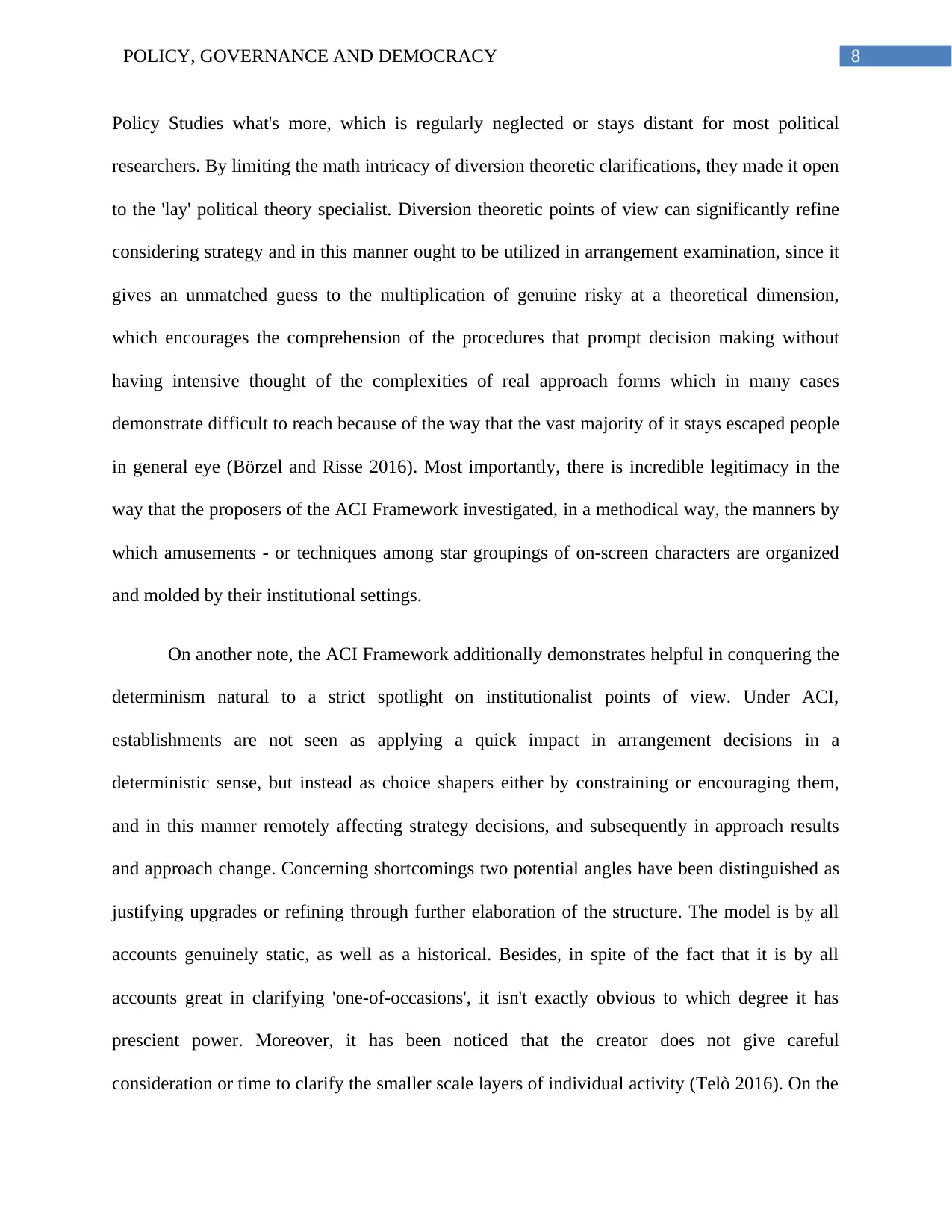
8POLICY, GOVERNANCE AND DEMOCRACY
Policy Studies what's more, which is regularly neglected or stays distant for most political
researchers. By limiting the math intricacy of diversion theoretic clarifications, they made it open
to the 'lay' political theory specialist. Diversion theoretic points of view can significantly refine
considering strategy and in this manner ought to be utilized in arrangement examination, since it
gives an unmatched guess to the multiplication of genuine risky at a theoretical dimension,
which encourages the comprehension of the procedures that prompt decision making without
having intensive thought of the complexities of real approach forms which in many cases
demonstrate difficult to reach because of the way that the vast majority of it stays escaped people
in general eye (Börzel and Risse 2016). Most importantly, there is incredible legitimacy in the
way that the proposers of the ACI Framework investigated, in a methodical way, the manners by
which amusements - or techniques among star groupings of on-screen characters are organized
and molded by their institutional settings.
On another note, the ACI Framework additionally demonstrates helpful in conquering the
determinism natural to a strict spotlight on institutionalist points of view. Under ACI,
establishments are not seen as applying a quick impact in arrangement decisions in a
deterministic sense, but instead as choice shapers either by constraining or encouraging them,
and in this manner remotely affecting strategy decisions, and subsequently in approach results
and approach change. Concerning shortcomings two potential angles have been distinguished as
justifying upgrades or refining through further elaboration of the structure. The model is by all
accounts genuinely static, as well as a historical. Besides, in spite of the fact that it is by all
accounts great in clarifying 'one-of-occasions', it isn't exactly obvious to which degree it has
prescient power. Moreover, it has been noticed that the creator does not give careful
consideration or time to clarify the smaller scale layers of individual activity (Telò 2016). On the
Policy Studies what's more, which is regularly neglected or stays distant for most political
researchers. By limiting the math intricacy of diversion theoretic clarifications, they made it open
to the 'lay' political theory specialist. Diversion theoretic points of view can significantly refine
considering strategy and in this manner ought to be utilized in arrangement examination, since it
gives an unmatched guess to the multiplication of genuine risky at a theoretical dimension,
which encourages the comprehension of the procedures that prompt decision making without
having intensive thought of the complexities of real approach forms which in many cases
demonstrate difficult to reach because of the way that the vast majority of it stays escaped people
in general eye (Börzel and Risse 2016). Most importantly, there is incredible legitimacy in the
way that the proposers of the ACI Framework investigated, in a methodical way, the manners by
which amusements - or techniques among star groupings of on-screen characters are organized
and molded by their institutional settings.
On another note, the ACI Framework additionally demonstrates helpful in conquering the
determinism natural to a strict spotlight on institutionalist points of view. Under ACI,
establishments are not seen as applying a quick impact in arrangement decisions in a
deterministic sense, but instead as choice shapers either by constraining or encouraging them,
and in this manner remotely affecting strategy decisions, and subsequently in approach results
and approach change. Concerning shortcomings two potential angles have been distinguished as
justifying upgrades or refining through further elaboration of the structure. The model is by all
accounts genuinely static, as well as a historical. Besides, in spite of the fact that it is by all
accounts great in clarifying 'one-of-occasions', it isn't exactly obvious to which degree it has
prescient power. Moreover, it has been noticed that the creator does not give careful
consideration or time to clarify the smaller scale layers of individual activity (Telò 2016). On the
⊘ This is a preview!⊘
Do you want full access?
Subscribe today to unlock all pages.

Trusted by 1+ million students worldwide
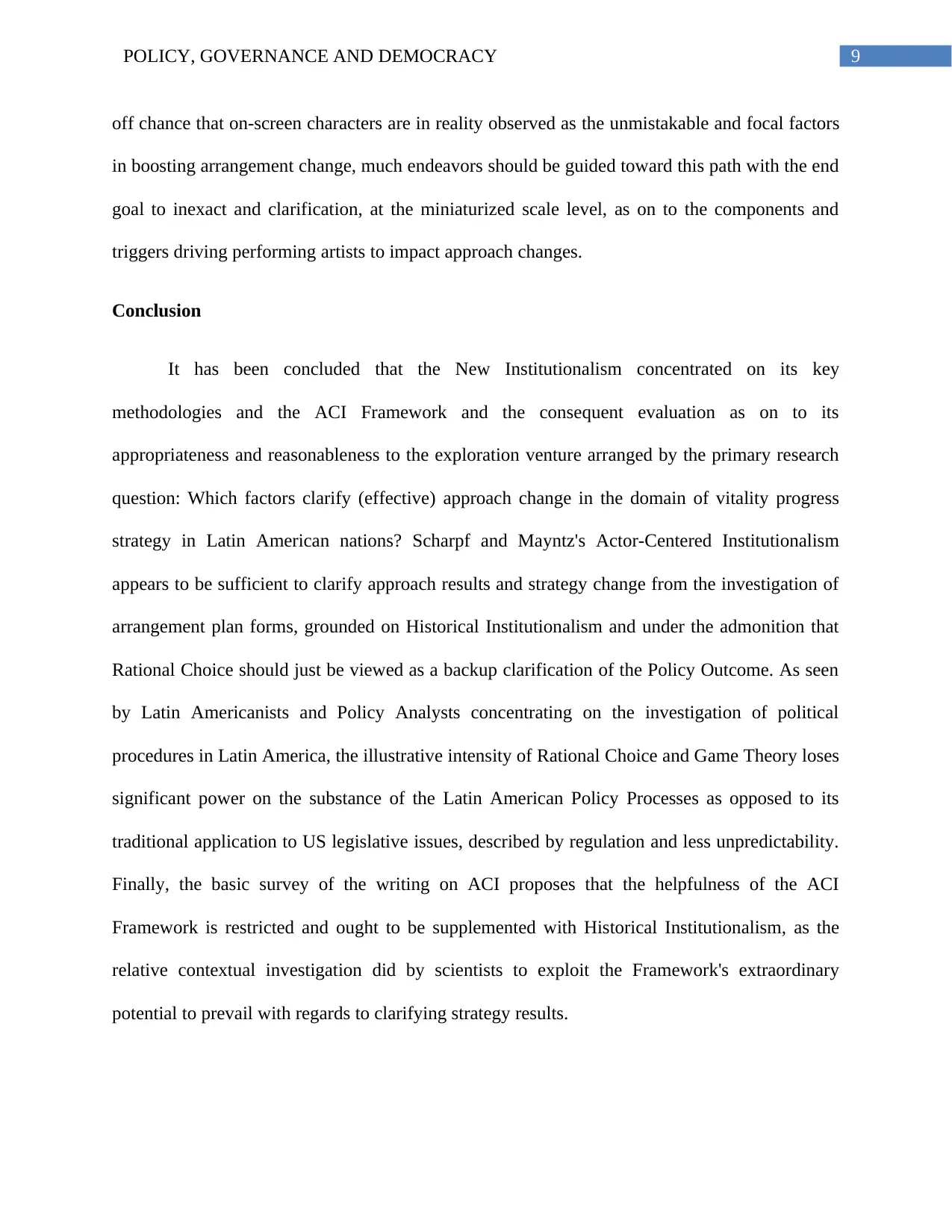
9POLICY, GOVERNANCE AND DEMOCRACY
off chance that on-screen characters are in reality observed as the unmistakable and focal factors
in boosting arrangement change, much endeavors should be guided toward this path with the end
goal to inexact and clarification, at the miniaturized scale level, as on to the components and
triggers driving performing artists to impact approach changes.
Conclusion
It has been concluded that the New Institutionalism concentrated on its key
methodologies and the ACI Framework and the consequent evaluation as on to its
appropriateness and reasonableness to the exploration venture arranged by the primary research
question: Which factors clarify (effective) approach change in the domain of vitality progress
strategy in Latin American nations? Scharpf and Mayntz's Actor-Centered Institutionalism
appears to be sufficient to clarify approach results and strategy change from the investigation of
arrangement plan forms, grounded on Historical Institutionalism and under the admonition that
Rational Choice should just be viewed as a backup clarification of the Policy Outcome. As seen
by Latin Americanists and Policy Analysts concentrating on the investigation of political
procedures in Latin America, the illustrative intensity of Rational Choice and Game Theory loses
significant power on the substance of the Latin American Policy Processes as opposed to its
traditional application to US legislative issues, described by regulation and less unpredictability.
Finally, the basic survey of the writing on ACI proposes that the helpfulness of the ACI
Framework is restricted and ought to be supplemented with Historical Institutionalism, as the
relative contextual investigation did by scientists to exploit the Framework's extraordinary
potential to prevail with regards to clarifying strategy results.
off chance that on-screen characters are in reality observed as the unmistakable and focal factors
in boosting arrangement change, much endeavors should be guided toward this path with the end
goal to inexact and clarification, at the miniaturized scale level, as on to the components and
triggers driving performing artists to impact approach changes.
Conclusion
It has been concluded that the New Institutionalism concentrated on its key
methodologies and the ACI Framework and the consequent evaluation as on to its
appropriateness and reasonableness to the exploration venture arranged by the primary research
question: Which factors clarify (effective) approach change in the domain of vitality progress
strategy in Latin American nations? Scharpf and Mayntz's Actor-Centered Institutionalism
appears to be sufficient to clarify approach results and strategy change from the investigation of
arrangement plan forms, grounded on Historical Institutionalism and under the admonition that
Rational Choice should just be viewed as a backup clarification of the Policy Outcome. As seen
by Latin Americanists and Policy Analysts concentrating on the investigation of political
procedures in Latin America, the illustrative intensity of Rational Choice and Game Theory loses
significant power on the substance of the Latin American Policy Processes as opposed to its
traditional application to US legislative issues, described by regulation and less unpredictability.
Finally, the basic survey of the writing on ACI proposes that the helpfulness of the ACI
Framework is restricted and ought to be supplemented with Historical Institutionalism, as the
relative contextual investigation did by scientists to exploit the Framework's extraordinary
potential to prevail with regards to clarifying strategy results.
Paraphrase This Document
Need a fresh take? Get an instant paraphrase of this document with our AI Paraphraser
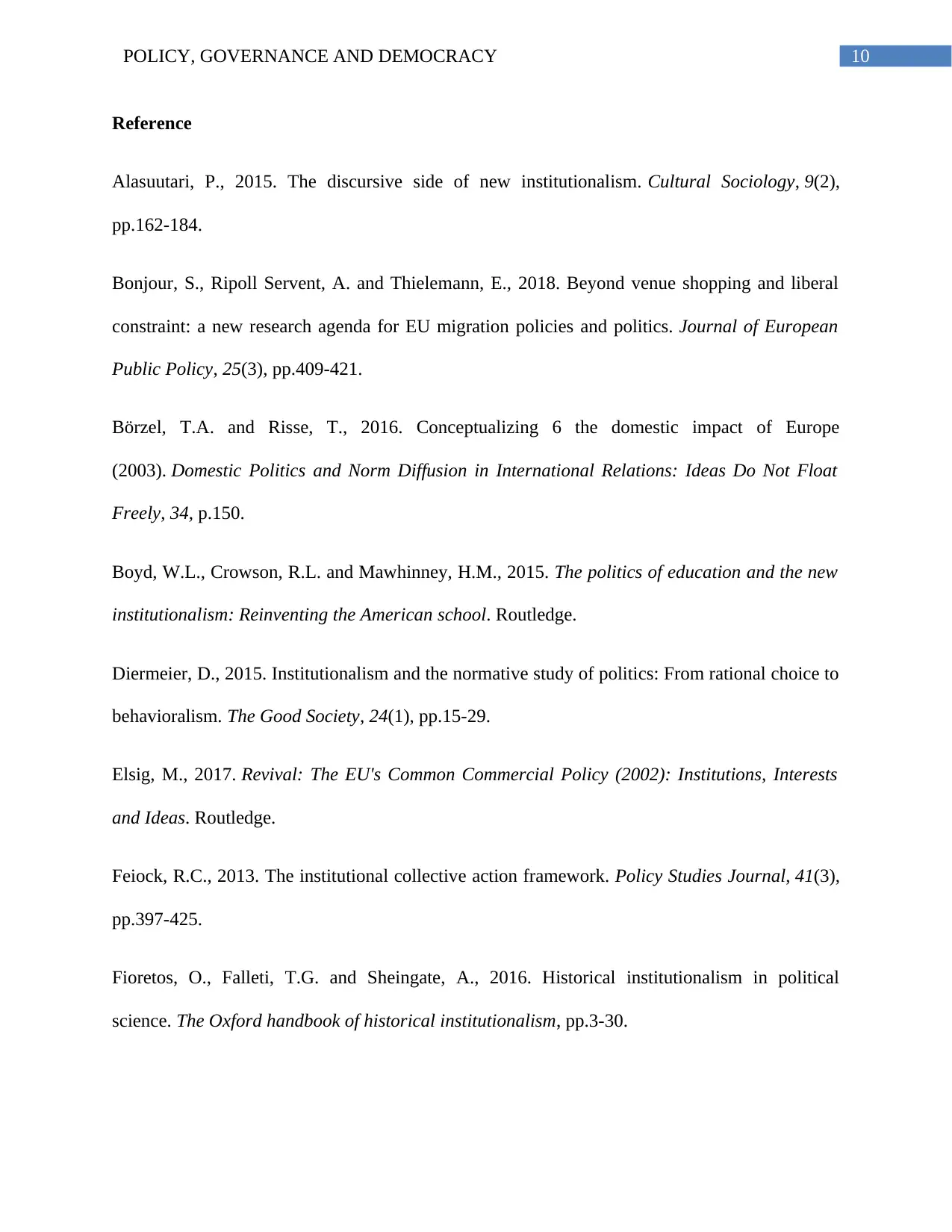
10POLICY, GOVERNANCE AND DEMOCRACY
Reference
Alasuutari, P., 2015. The discursive side of new institutionalism. Cultural Sociology, 9(2),
pp.162-184.
Bonjour, S., Ripoll Servent, A. and Thielemann, E., 2018. Beyond venue shopping and liberal
constraint: a new research agenda for EU migration policies and politics. Journal of European
Public Policy, 25(3), pp.409-421.
Börzel, T.A. and Risse, T., 2016. Conceptualizing 6 the domestic impact of Europe
(2003). Domestic Politics and Norm Diffusion in International Relations: Ideas Do Not Float
Freely, 34, p.150.
Boyd, W.L., Crowson, R.L. and Mawhinney, H.M., 2015. The politics of education and the new
institutionalism: Reinventing the American school. Routledge.
Diermeier, D., 2015. Institutionalism and the normative study of politics: From rational choice to
behavioralism. The Good Society, 24(1), pp.15-29.
Elsig, M., 2017. Revival: The EU's Common Commercial Policy (2002): Institutions, Interests
and Ideas. Routledge.
Feiock, R.C., 2013. The institutional collective action framework. Policy Studies Journal, 41(3),
pp.397-425.
Fioretos, O., Falleti, T.G. and Sheingate, A., 2016. Historical institutionalism in political
science. The Oxford handbook of historical institutionalism, pp.3-30.
Reference
Alasuutari, P., 2015. The discursive side of new institutionalism. Cultural Sociology, 9(2),
pp.162-184.
Bonjour, S., Ripoll Servent, A. and Thielemann, E., 2018. Beyond venue shopping and liberal
constraint: a new research agenda for EU migration policies and politics. Journal of European
Public Policy, 25(3), pp.409-421.
Börzel, T.A. and Risse, T., 2016. Conceptualizing 6 the domestic impact of Europe
(2003). Domestic Politics and Norm Diffusion in International Relations: Ideas Do Not Float
Freely, 34, p.150.
Boyd, W.L., Crowson, R.L. and Mawhinney, H.M., 2015. The politics of education and the new
institutionalism: Reinventing the American school. Routledge.
Diermeier, D., 2015. Institutionalism and the normative study of politics: From rational choice to
behavioralism. The Good Society, 24(1), pp.15-29.
Elsig, M., 2017. Revival: The EU's Common Commercial Policy (2002): Institutions, Interests
and Ideas. Routledge.
Feiock, R.C., 2013. The institutional collective action framework. Policy Studies Journal, 41(3),
pp.397-425.
Fioretos, O., Falleti, T.G. and Sheingate, A., 2016. Historical institutionalism in political
science. The Oxford handbook of historical institutionalism, pp.3-30.
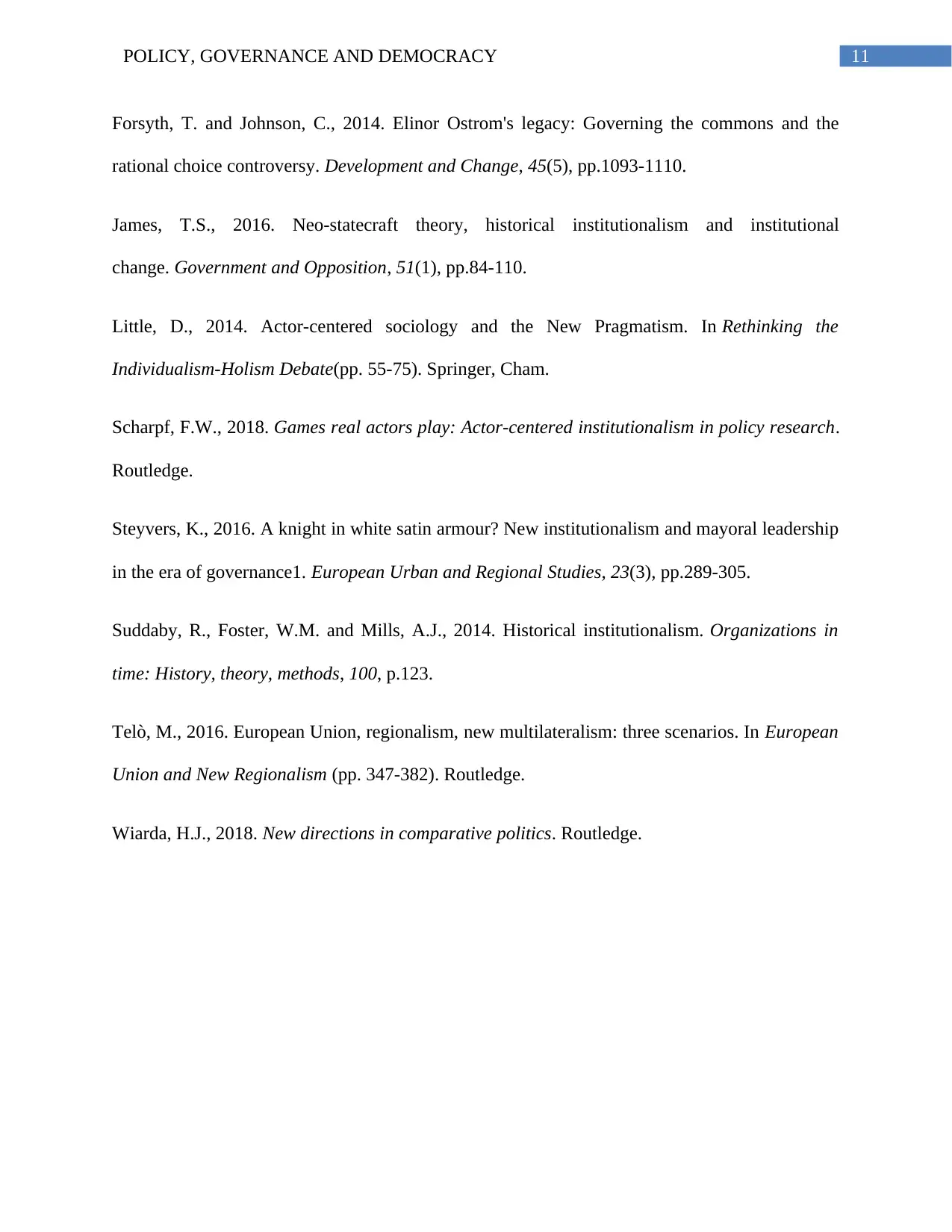
11POLICY, GOVERNANCE AND DEMOCRACY
Forsyth, T. and Johnson, C., 2014. Elinor Ostrom's legacy: Governing the commons and the
rational choice controversy. Development and Change, 45(5), pp.1093-1110.
James, T.S., 2016. Neo-statecraft theory, historical institutionalism and institutional
change. Government and Opposition, 51(1), pp.84-110.
Little, D., 2014. Actor-centered sociology and the New Pragmatism. In Rethinking the
Individualism-Holism Debate(pp. 55-75). Springer, Cham.
Scharpf, F.W., 2018. Games real actors play: Actor-centered institutionalism in policy research.
Routledge.
Steyvers, K., 2016. A knight in white satin armour? New institutionalism and mayoral leadership
in the era of governance1. European Urban and Regional Studies, 23(3), pp.289-305.
Suddaby, R., Foster, W.M. and Mills, A.J., 2014. Historical institutionalism. Organizations in
time: History, theory, methods, 100, p.123.
Telò, M., 2016. European Union, regionalism, new multilateralism: three scenarios. In European
Union and New Regionalism (pp. 347-382). Routledge.
Wiarda, H.J., 2018. New directions in comparative politics. Routledge.
Forsyth, T. and Johnson, C., 2014. Elinor Ostrom's legacy: Governing the commons and the
rational choice controversy. Development and Change, 45(5), pp.1093-1110.
James, T.S., 2016. Neo-statecraft theory, historical institutionalism and institutional
change. Government and Opposition, 51(1), pp.84-110.
Little, D., 2014. Actor-centered sociology and the New Pragmatism. In Rethinking the
Individualism-Holism Debate(pp. 55-75). Springer, Cham.
Scharpf, F.W., 2018. Games real actors play: Actor-centered institutionalism in policy research.
Routledge.
Steyvers, K., 2016. A knight in white satin armour? New institutionalism and mayoral leadership
in the era of governance1. European Urban and Regional Studies, 23(3), pp.289-305.
Suddaby, R., Foster, W.M. and Mills, A.J., 2014. Historical institutionalism. Organizations in
time: History, theory, methods, 100, p.123.
Telò, M., 2016. European Union, regionalism, new multilateralism: three scenarios. In European
Union and New Regionalism (pp. 347-382). Routledge.
Wiarda, H.J., 2018. New directions in comparative politics. Routledge.
⊘ This is a preview!⊘
Do you want full access?
Subscribe today to unlock all pages.

Trusted by 1+ million students worldwide
1 out of 12
Related Documents
Your All-in-One AI-Powered Toolkit for Academic Success.
+13062052269
info@desklib.com
Available 24*7 on WhatsApp / Email
![[object Object]](/_next/static/media/star-bottom.7253800d.svg)
Unlock your academic potential
Copyright © 2020–2025 A2Z Services. All Rights Reserved. Developed and managed by ZUCOL.



